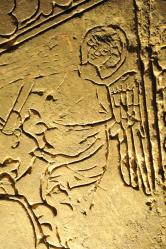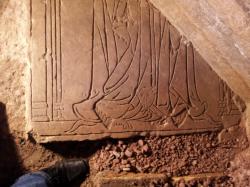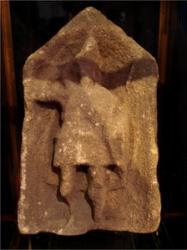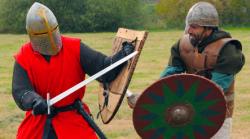INSTITUT SUPERIEUR D'ANTHROPOLOGIE
INSTITUTE OF ANTHROPOLOGY
ONLINE COURSES / COURS A DISTANCE
SPRING SESSION : APRIL 2013
REGISTER NOW
ROYAUME UNI –  Londres - Crossrail workers are shocked to discover 13 skeletons buried under a square in the City of London - and archaeologists say a mass grave containing the bones of 50,000 people could be nearby. The 13 bodies met their unfortunate demise almost seven centuries ago, when the plague swept through Europe and killed over a quarter of the British population in 1348. But it was a piece of pottery found in the graves which dates back to around 1350, as well as the neat layout of the bodies in two rows, that gave archaeologists the clues as to when - and why - they died. The skeletons were found lying in neat rows under Charterhouse Square in Farringdon, 2.4 metres below the road, during excavation work for London's £14.8bn Crossrail project. And according to archaeologists, there could up to 50,000 more skeletons buried nearby.
Londres - Crossrail workers are shocked to discover 13 skeletons buried under a square in the City of London - and archaeologists say a mass grave containing the bones of 50,000 people could be nearby. The 13 bodies met their unfortunate demise almost seven centuries ago, when the plague swept through Europe and killed over a quarter of the British population in 1348. But it was a piece of pottery found in the graves which dates back to around 1350, as well as the neat layout of the bodies in two rows, that gave archaeologists the clues as to when - and why - they died. The skeletons were found lying in neat rows under Charterhouse Square in Farringdon, 2.4 metres below the road, during excavation work for London's £14.8bn Crossrail project. And according to archaeologists, there could up to 50,000 more skeletons buried nearby.
VIDEO = http://www.channel4.com/news/skeleton-black-death-crossrail-excavation-13-archaeology
FRANCE – 
 Caen - Le programme de consolidation de l’église Saint-Jean, actuellement fermée au public, a été accompagné de fouilles. « Nous avons découvert entre les piliers de la tour, qu’une tranchée avait été réalisée au XVe siècle et qu’auparavant le sol était 1,30 m plus bas qu’aujourd’hui. Sur ce sol, étaient posées des plaques funéraires dans un état de conservation exceptionnel. Elles livrent l’histoire de bourgeois vivant à Caen aux XIVe et XVe siècles », explique François Fichet de Clairefontaine, conservateur régional de l’archéologie. C’est à partir des noms et des dates inscrits sur ces plaques que les archéologues ont pu remonter le temps. Retirées pour poser des pieux de consolidation, les plaques seront exposées avec des panneaux explicatifs dans l’église Saint-Jean à sa réouverture. Certaines plaques engagées sous le chemisage n’ont pu être retirées. Autre découverte dans les sous-sols de l’église : des petits ossuaires. « On imagine que c’est une partie des squelettes de ces bourgeois. Le reste est peut-être enterré dans l’un des cimetières de Caen. »
Caen - Le programme de consolidation de l’église Saint-Jean, actuellement fermée au public, a été accompagné de fouilles. « Nous avons découvert entre les piliers de la tour, qu’une tranchée avait été réalisée au XVe siècle et qu’auparavant le sol était 1,30 m plus bas qu’aujourd’hui. Sur ce sol, étaient posées des plaques funéraires dans un état de conservation exceptionnel. Elles livrent l’histoire de bourgeois vivant à Caen aux XIVe et XVe siècles », explique François Fichet de Clairefontaine, conservateur régional de l’archéologie. C’est à partir des noms et des dates inscrits sur ces plaques que les archéologues ont pu remonter le temps. Retirées pour poser des pieux de consolidation, les plaques seront exposées avec des panneaux explicatifs dans l’église Saint-Jean à sa réouverture. Certaines plaques engagées sous le chemisage n’ont pu être retirées. Autre découverte dans les sous-sols de l’église : des petits ossuaires. « On imagine que c’est une partie des squelettes de ces bourgeois. Le reste est peut-être enterré dans l’un des cimetières de Caen. »
http://www.cotecaen.fr/22242/a-caen-decouvertes-surprenantes-dans-leglise-saint-jean/
FRANCE – Montemart - Les fouilles topographiques du projet Montemart sont terminées. Cette fois, les archéologues se sont intéressés au bourg ancien. Place du Dojo, les fouilles préventives, en attendant la résidence intergénérationnelle, sont également finies. Castrum de Montemart. Après une première étude de recherches historiques en 2011, menée par le cabinet Hades, une seconde phase vient de se conclure. Les architectes sont revenus tout récemment pour mener une étude topographique. Il s'agissait d'étendre les recherches autour du castrum et de travailler sur le bourg ancien de Malemort. Ainsi, six maisons ont été visitées avec l'accord des propriétaires. Quatre se situent dans l'emprise du bourg, une au-dessus du site de Montemart et une, adossée au site. Des voûtes de pierres, des caves, des cheminées, des baies, des piliers… plusieurs vestiges ont été examinés et pour certains datés du XV e et XVI e siècle. D'après les premiers éléments, il y avait sans doute une vie paysanne avec peut-être de la production pour les seigneurs mais tout cela demande à être confirmé et les archéologues vont revenir "gratter" chez les gens pour affiner ». Foyer intergénérationnel. Il y a quelques jours, place François-Mitterrand (place du Dojo) ont eu lieu les fouilles préventives sur huit points à l'emplacement du futur foyer logement. Le prestataire, l'Inrap, a creusé sur trente mètres de long et trois mètres de profondeur. A priori, pas de découverte majeure. Seuls des remblais et les fondations d'un mur qui pourrait appartenir à une ancienne papeterie ont été mis à jour.
http://www.lamontagne.fr/limousin/actualite/departement/correze/brive/2013/03/15/montemart-devoile-peu-a-peu-ses-tresors-et-le-foyer-logement-se-prepare-a-sortir-de-terre-1477179.html
CHINE – Sunjiadong caves - Chinese paleoanthropologists have given the name Luanchuan Man to Homo erectus fossil specimens discovered in central China's Henan Province. The fossilized teeth of an early human were recently discovered at the Sunjiadong excavation site in Luanchuan County in the city of Luoyang. Researchers from the Henan Provincial Bureau of Cultural Relics said on Thursday that the teeth came from the skull of a deceased minor. The extinct Homo erectus species is believed to have lived around 2 million to 200,000 years ago. Li Zhanyang, a member of an archaeological research team in Henan, said experts believe the stratum of the Sunjiadong site belongs to the middle Pleistocene period, or the same period as Peking Man, an example of Homo erectus that was discovered in the Zhoukoudian cave system near Beijing in the early 20th century. The Henan bureau has convened experts from the Institute of Vertebrate Paleontology and Paleoanthropology (IVPP) under the Chinese Academy of Sciences and the Archeological Institute under the Chinese Academy of Social Sciences to study the new fossils. They have jointly agreed on the name of the finding. Gao Xing, a member of the IVPP, said there have been few new Homo erectus fossil discoveries in the world. The Sunjiadong site will provide more data to advance paleoanthropological studies, he said. In the Sunjiadong caves, archaeologists have also unearthed a large amount of ancient animal fossils, including deer and rhinoceros, that are similar to those found in Zhoukoudian.
http://www.kaogu.cn/en/detail.asp?ProductID=3932
ROYAUME UNI –  Sudeley – A Roman sculpture of a Cotswold god has been found in a castle cupboard after being missing for over 100 years. The artefact, dated 150-350AD, was first found during an archaeological dig on the estate of Sudeley Castle in 1875. But when historians found records of the discovery in the 1960s, there was no trace of the sculpture.The Roman altar God has now been found in a basement cupboard during a clear out at the Gloucestershire castle. The engraved figure, found earlier this month, wears a conical cap, tunic and cloak and holds a bow and arrow. It has been identified by historians as Cotswold deity Apollo the Hound Prince or Apollo Cunomaglos. Experts believe there are only seven other known depictions, four from the Cotswolds and three from London, and say the discovery is a significant find.
Sudeley – A Roman sculpture of a Cotswold god has been found in a castle cupboard after being missing for over 100 years. The artefact, dated 150-350AD, was first found during an archaeological dig on the estate of Sudeley Castle in 1875. But when historians found records of the discovery in the 1960s, there was no trace of the sculpture.The Roman altar God has now been found in a basement cupboard during a clear out at the Gloucestershire castle. The engraved figure, found earlier this month, wears a conical cap, tunic and cloak and holds a bow and arrow. It has been identified by historians as Cotswold deity Apollo the Hound Prince or Apollo Cunomaglos. Experts believe there are only seven other known depictions, four from the Cotswolds and three from London, and say the discovery is a significant find.
http://www.bbc.co.uk/news/uk-england-gloucestershire-21800190
POLOGNE –  Kwidzyn - Polish archaeologists said this week that they had identified the remains of three leaders of the Teutonic Knights, an armed religious order that ruled swathes of the country centuries ago. "Anthropological and DNA testing has enabled us to back up the theory that these are the remains of the grand masters. We can be 96 percent certain," Bogumil Wisniewski, head of a team which found the skeletons, told AFP on Thursday. Wisniewski said his team was convinced the men were Werner von Orseln, who led the knights from 1324-1330, Ludolf Koenig (1342-1345), and Heinrich von Plauen (1410-1413). The three skeletons were discovered in May 2007 in a crypt under the cathedral in Kwidzyn in northern Poland - formerly known by the German name Marienwerder - along with pieces of silk and ornate brooches, which were a sign of high religious rank. Studies of the wood of the coffins confirmed that they were from the right period. The Teutonic Knights' order was founded in the Holy Land in 1190, during the Third Crusade. Despite its name, its members came from a handful of European regions, and not only German-speaking areas. In 1226 the Polish Duke Konrad of Mazovia invited the knights to help him conquer the pagan population of neighbouring Prussia. The order gradually took control of large stretches of the Baltic coast, establishing a state with its capital at Marienburg - today's Malbork in northern Poland. The knights fought a string of successful military campaigns against their neighbours. But their power declined after they were defeated by an army of Poles and Lithuanians in 1410 at the Battle of Grunwald, which is still seen as a key moment in the history of both peoples. The order lost its religious character in the 16th century, and its domain was transformed into the Duchy of Prussia, which endured in various guises until Germany lost the territory to Poland and Russia after World War II.
Kwidzyn - Polish archaeologists said this week that they had identified the remains of three leaders of the Teutonic Knights, an armed religious order that ruled swathes of the country centuries ago. "Anthropological and DNA testing has enabled us to back up the theory that these are the remains of the grand masters. We can be 96 percent certain," Bogumil Wisniewski, head of a team which found the skeletons, told AFP on Thursday. Wisniewski said his team was convinced the men were Werner von Orseln, who led the knights from 1324-1330, Ludolf Koenig (1342-1345), and Heinrich von Plauen (1410-1413). The three skeletons were discovered in May 2007 in a crypt under the cathedral in Kwidzyn in northern Poland - formerly known by the German name Marienwerder - along with pieces of silk and ornate brooches, which were a sign of high religious rank. Studies of the wood of the coffins confirmed that they were from the right period. The Teutonic Knights' order was founded in the Holy Land in 1190, during the Third Crusade. Despite its name, its members came from a handful of European regions, and not only German-speaking areas. In 1226 the Polish Duke Konrad of Mazovia invited the knights to help him conquer the pagan population of neighbouring Prussia. The order gradually took control of large stretches of the Baltic coast, establishing a state with its capital at Marienburg - today's Malbork in northern Poland. The knights fought a string of successful military campaigns against their neighbours. But their power declined after they were defeated by an army of Poles and Lithuanians in 1410 at the Battle of Grunwald, which is still seen as a key moment in the history of both peoples. The order lost its religious character in the 16th century, and its domain was transformed into the Duchy of Prussia, which endured in various guises until Germany lost the territory to Poland and Russia after World War II.
http://www.thelocal.de/society/20081212-16083.html#.UUOFDxw011B